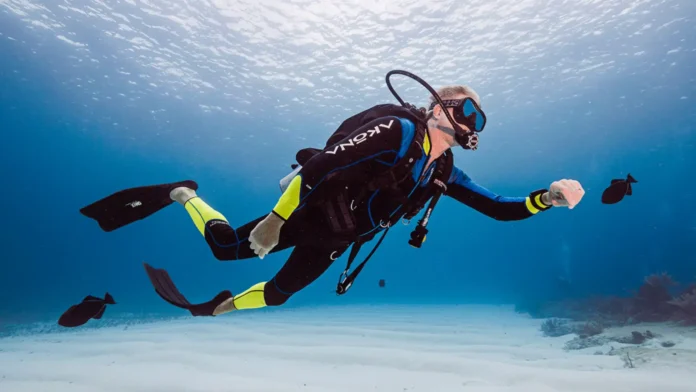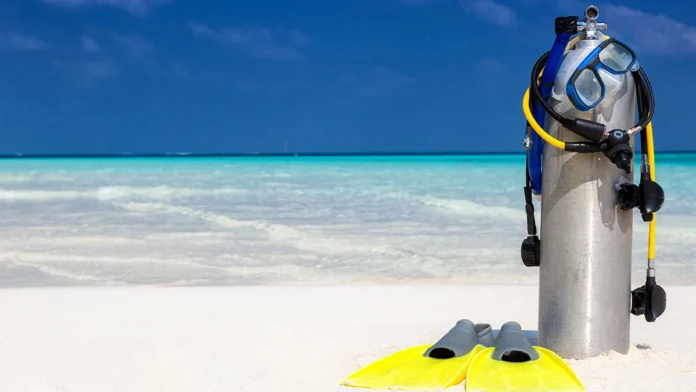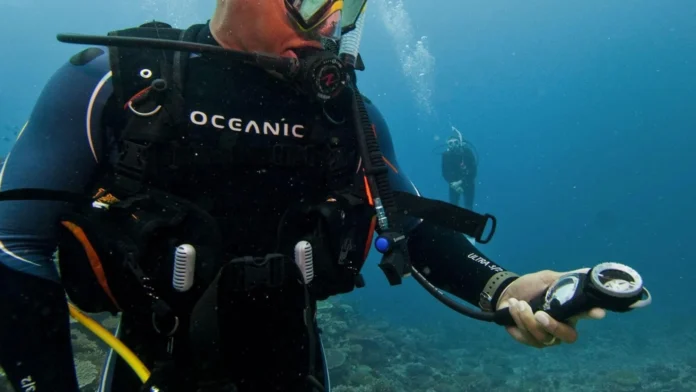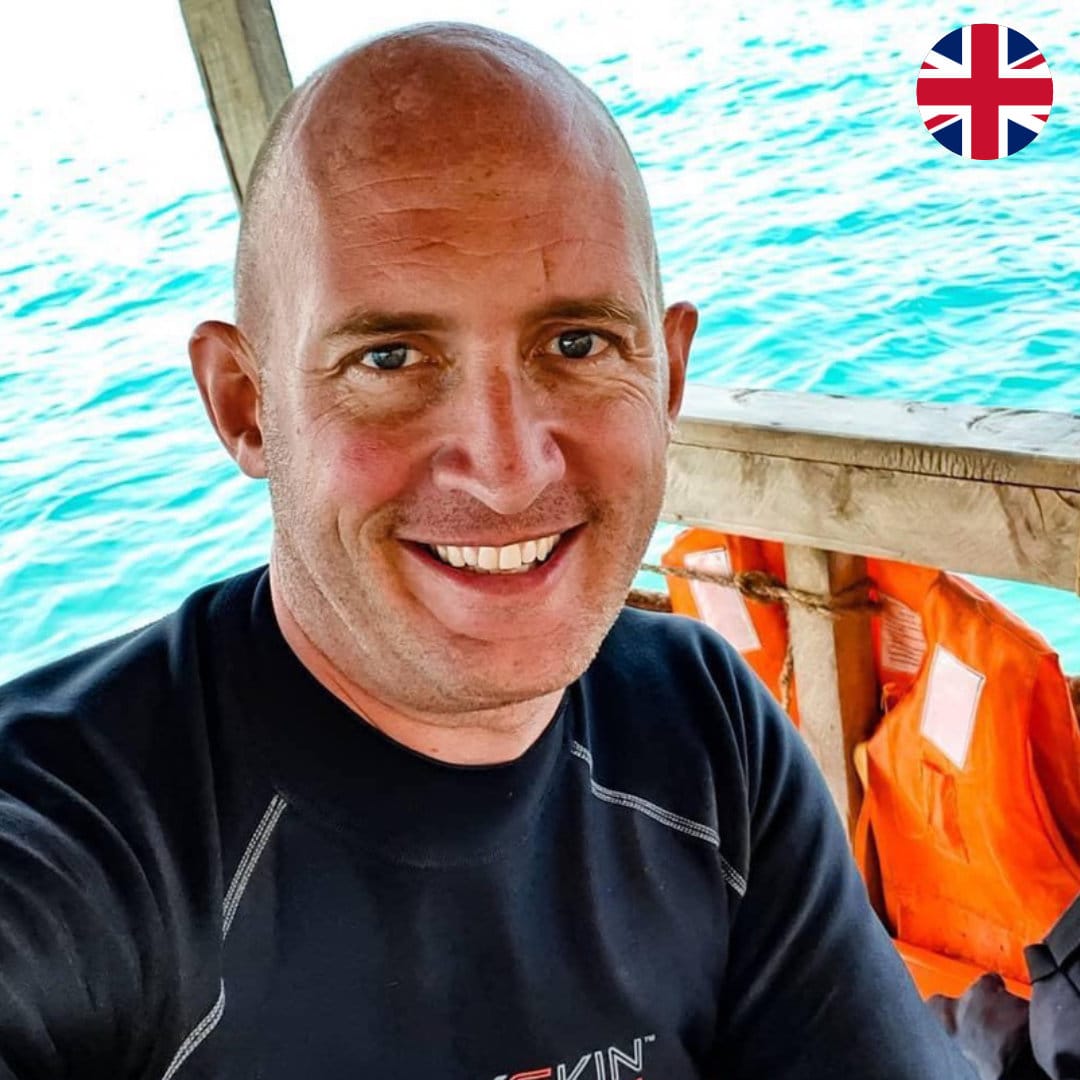Have you ever wondered what is the deepest anyone has gone on scuba? The current answer is over 332 meters (at the time of writing in September 2025). This record pushes the limits of human physiology and scuba technology. For decades, divers have tried to set records to discover the deepest anyone has gone on scuba. This article looks at the history of these attempts, the dangers of extreme depth, and how scuba compares to freediving and submersibles.
A History of Record-Breaking Deep Dives
The first major attempts began in the 1960s. In 1960, Swiss diver Hannes Keller reached 100 meters in a lake using scuba gear. At the time this was groundbreaking. In the following decades, technology and techniques improved, allowing divers to go deeper. By the late 1980s, legendary cave diver Sheck Exley had reached about 265 meters. In 1994 he died attempting an even deeper dive in Mexico’s Zacatón sinkhole. His dive computer showed he had gone down to 276 meters before tragedy struck.
The 300 meter barrier was first broken in 2001 by John Bennett of Australia, who descended to 308 meters. In 2003, British diver Mark Ellyatt reached 313 meters in Thailand. South African diver Nuno Gomes took the record in 2005 with a depth of 318.25 meters in the Red Sea. That same year, French diver Pascal Bernabé claimed 330 meters near Corsica. Guinness World Records did not recognize Bernabé’s dive because the evidence was not sufficient. Gomes’s record stood officially.
The current record for the deepest anyone has gone on scuba was set by Ahmed Gabr of Egypt in 2014. He reached 332.35 meters in the Red Sea, and this record is certified by Guinness World Records. Gabr’s descent took about 15 minutes, but his ascent lasted almost 15 hours because of the many decompression stops required.
There are other related records. In 1996, Nuno Gomes also set the deepest cave dive record at 282 meters in Boesmansgat, South Africa. In 2004, Verna van Schaik set the women’s record at 221 meters in the same cave. These records show both the potential and the dangers of deep scuba diving.
The Challenges and Dangers of Extreme Depths
Going hundreds of meters deep on scuba is very different from normal diving. At 300 meters, the water pressure is more than 30 times that of the surface. This creates serious risks for anyone attempting to reach the deepest anyone has gone on scuba.
- Nitrogen Narcosis: At depth, nitrogen in the breathing gas affects the brain. It can cause confusion and euphoria, like being drunk. To avoid this, divers replace much of the nitrogen with helium, using special gas mixes called trimix.
- Oxygen Toxicity: At high pressure, oxygen becomes toxic. It can cause seizures or blackouts. Deep divers lower the oxygen content in their gas mixes to reduce this risk.
- Decompression Sickness: As divers go deep, nitrogen dissolves into body tissues. If they ascend too fast, nitrogen bubbles can form and block circulation. This is known as “the bends.” To prevent this, divers ascend very slowly with planned decompression stops.
- Equipment Strain: Regulators, tanks, hoses, and masks are under huge stress at extreme depths. A single failure could be fatal. For safety, divers carry redundant tanks and equipment.
- Cold and Darkness: At 300 meters, it is pitch dark and close to freezing. Divers wear insulated suits or heated suits to survive. Powerful lights are also essential.
Even with training and planning, deep dives can be deadly. Sheck Exley in 1994 and Guy “Doc Deep” Garman in 2015 both died in attempts to break depth records.
Scuba vs Freediving vs Submersibles
It helps to compare scuba diving with other ways of reaching the deep ocean.
- Freediving: Divers descend on a single breath. In 2007, Austrian freediver Herbert Nitsch set the record at 214 meters in the “No Limits” category. Freedivers avoid decompression problems but face blackout risks from lack of oxygen.
- Scuba Diving: Scuba allows longer exploration but has a hard limit around 332 meters due to human physiology. Most recreational divers stay within 40 meters. Extreme depth records are rare and dangerous, with limited scientific value. Still, the deepest anyone has gone on scuba shows just how far the limits of the sport can be pushed.
- Submersibles: Humans have gone far deeper in submersibles. In 1960 the bathyscaphe Trieste reached 10,916 meters in the Mariana Trench. James Cameron in 2012 and Victor Vescovo in 2019 also dived submersibles to nearly 11,000 meters. Submersibles are designed for research and exploration. They allow humans to go thousands of meters deeper than scuba will ever allow.
Conclusion
The answer to what is the deepest anyone has gone on scuba is 332.35 meters, set by Ahmed Gabr in 2014. (at the time of writing in September 2025) Behind this number is a story of decades of attempts, triumphs, and tragedies. Scuba diving can only take us so far before physiology and physics stop us. Freedivers show what humans can do on one breath, while submersibles show how machines take us to the true depths.
The scuba record is not just a number. It is a testament to human courage, training, and the will to explore. For most divers, however, the real value lies in safe diving at normal depths, where the underwater world can be enjoyed without extreme risk.
References
- Verly Vee, Understanding the Most Incredible of Deep Diving, Bali Fun Diving Blog, Oct. 2023.
- Inside Scuba, Deep Diving Records: Exploration or Dangerous Obsession?, Feb. 2024.
- DIVE Magazine (UK), Scuba Diving World Records, Dec. 2021.
- Encyclopædia Britannica, Challenger Deep – Expeditions & Facts.






















